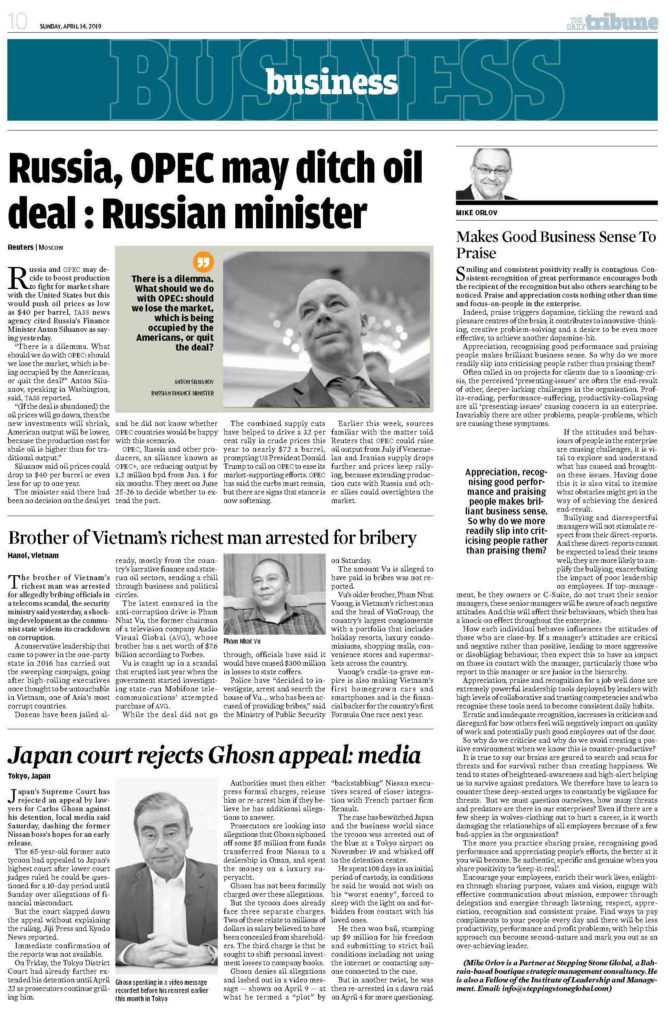
Smiling and consistent positivity really is contagious. Consistent-recognition of great performance encourages both the recipient of the recognition but also others searching to be noticed. Praise and appreciation costs nothing other than time and focus-on-people in the enterprise.
Indeed, praise triggers dopamine, tickling the reward and pleasure centres of the brain; it contributes to innovative-thinking, creative problem-solving and a desire to be even more effective, to achieve another dopamine-hit.
Appreciation, recognising good performance and praising people makes brilliant business sense. So why do we more readily slip into criticising people rather than praising them?
Often called in on projects for clients due to a looming-crisis, the perceived ‘presenting-issues’ are often the end-result of other, deeper-lurking challenges in the organisation. Profits-eroding, performance-suffering, productivity-collapsing are all ‘presenting-issues’ causing concern in an enterprise. Invariably there are other problems, people-problems, which are causing these symptoms.
If the attitudes and behaviours of people in the enterprise are causing challenges, it is vital to explore and understand what has caused and brought-on these issues. Having done this it is also vital to itemise what obstacles might get in the way of achieving the desired end-result.
Bullying and disrespectful managers will not stimulate respect from their direct-reports. And these direct-reports cannot be expected to lead their teams well; they are more likely to amplify the bullying, exacerbating the impact of poor leadership on employees. If top-management, be they owners or C-Suite, do not trust their senior managers, these senior managers will be aware of such negative attitudes. And this will affect their behaviours, which then has a knock-on effect throughout the enterprise.
How each individual behaves influences the attitudes of those who are close-by. If a manager’s attitudes are critical and negative rather than positive, leading to more aggressive or disobliging behaviour, then expect this to have an impact on those in contact with the manager, particularly those who report to this manager or are junior in the hierarchy.
Appreciation, praise and recognition for a job well done are extremely powerful leadership tools deployed by leaders with high levels of collaborative and trusting competencies and who recognise these tools need to become consistent daily habits.
Erratic and inadequate recognition, increases in criticism and disregard for how others feel will negatively impact on quality of work and potentially push good employees out of the door.
So why do we criticise and why do we avoid creating a positive environment when we know this is counter-productive?
It is true to say our brains are geared to search and scan for threats and for survival rather than creating happiness. We tend to states of heightened-awareness and high-alert helping us to survive against predators. We therefore have to learn to counter these deep-seated urges to constantly be vigilance for threats. But we must question ourselves, how many threats and predators are there in our enterprises? Even if there are a few sheep in wolves-clothing out to hurt a career, is it worth damaging the relationships of all employees because of a few bad-apples in the organisation?
The more you practice sharing praise, recognising good performance and appreciating people’s efforts, the better at it you will become. Be authentic, specific and genuine when you share positivity to ‘keep-it-real’.
Encourage your employees, enrich their work lives, enlighten through sharing purpose, values and vision, engage with effective communication about mission, empower through delegation and energise through listening, respect, appreciation, recognition and consistent praise. Find ways to pay compliments to your people every day and there will be less productivity, performance and profit problems; with help this approach can become second-nature and mark you out as an over-achieving leader.
